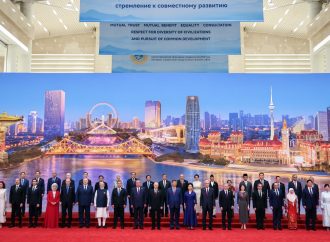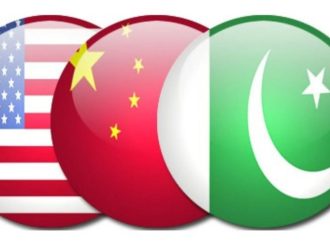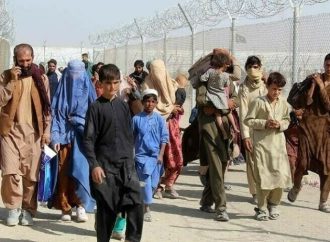Introduction
The Shanghai Cooperation Organization (SCO) is an intergovernmental organization established in Shanghai in 2001 that at the time comprised of China, Russia, Kazakhstan, Kyrgyzstan, Tajikistan, and Uzbekistan.
Initially created as a platform for building trust and demilitarizing borders, the organization’s objectives have since broadened encompassing greater economic cooperation, enhancing trade and intelligence sharing. Today, it is the largest regional organization globally in terms of geography and population, comprising almost 80 percent of the Eurasian landmass and 40 percent of the global population.
Origins in 1990s
In the mid-1990s, significant geopolitical shifts occurred following the collapse of the Soviet Union, laying the groundwork for the SCO. This period saw instability in Central Asia caused by territorial disputes, border issues and an increase in regional terrorism, which highlighted the need for joint security cooperation.
In response to these challenges, the Shanghai Five was formed in 1996 consisting of China, Russia, Kazakhstan, Kyrgyzstan, and Tajikistan. The primary goal at that time was to build trust and cooperation in matters of border management, counterterrorism and regional conflict resolution. The inaugural summit of the Shanghai Five took place in Shanghai, where member states concentrated on confidence-building measures and to alleviate tensions arising from territorial disputes.
Initially, the group’s activities were mainly focused on political and security concerns. However, as the nature of threats of started to become complicated, it became clear that a more coherent platform for collaboration was needed. This realization set the stage for the evolution of the Shanghai Five into a more comprehensive organization.
Evolution into SCO
In 2000, the Shanghai Five experienced a significant change with Uzbekistan’s entry. This laid the foundation in the formal establishment of the Shanghai Cooperation Organization in 2001. Unlike its predecessor, the SCO was more than just a security pact; it represented a broader scope aimed at ensuring regional stability and development through various forms of cooperation ranging from economic, cultural and political initiatives. Its founding charter emphasized a dedication to promoting peace, stability, and prosperity within the region. Moreover, it highlighted key principles such as non-interference in domestic matters and the respect for national sovereignty. The evolution of the organization reflects the changing dynamics of international relations and the collective interests of states.
Geopolitical Role
The early 2000s represented a critical turning point for the SCO. During this time period, the importance of the SCO increased with the changing geopolitical landscape, particularly due to the rise of global terrorism and the U.S. War on Terror in Afghanistan. Key member states, mainly China and Russia, aimed to promote their interests in regional security and diminish U.S.-led western influence. As such, the SCO transformed into a key player in regional security matters. Ultimately, this period set the foundation for the SCO’s role in addressing contemporary challenges and playing a leading role for stability in the region.
Expansion
In 2017, the organization welcomed India and Pakistan followed by Iran in 2023, which bolstered its reputation as a prominent regional body. The inclusion of these states not only expanded the political and economic dimensions of the SCO but also highlighted its standing as a platform for dialogue among major powers with diverse interests. The organization continues to evolve and expand its reach, reflecting the changing geopolitical realities of today.
Current Members and Areas of Interest
Today, the SCO consists of nine member states: China, Russia, India, Pakistan, Iran, Kazakhstan, Kyrgyzstan, Tajikistan, and Uzbekistan. Further, it includes several observer states and dialogue partners. The scope of the SCO’s influence has shifted from being security centric to encompassing a wide array of issues such as economic partnerships, trade connectivity and energy conservation. China’s Belt and Road Initiative aligns well with the objectives of the SCO, facilitating economic growth in Central Asia. On top of this, the SCO has placed increased emphasis on regional economic initiatives such as the proposed integration of the China’s Silk Road Economic Belt with the Russia’s Eurasian Economic Union.
These issues unite member states in addressing these complex challenges collectively. Regular summits and ministerial meetings support continuous dialogue and exchange of ideas. All in all, the SCO plays a leading role in promoting stability and cooperation across its member states.
Challenges, Critique and Future Prospects
The SCO has crossed a number of milestones, yet it faces considerable challenges ahead. A major stumbling block is the differing national interests of its prominent member states, arch rivals Pakistan and India, which many a times hinder cooperative initiatives from being implemented.
Many Western states raise questions about the organization being used to give authoritarian regimes a platform to legitimize their aggressive actions, such as Russia’s invasion of Ukraine and China’s assertiveness in the South China Sea and towards Taiwan. This perception is somewhat complicated with the presence of India, which is seen as a western counterbalance to China in the region.
The organization has faced criticism for prioritizing rhetoric over action, as it has not reached the level of economic cooperation evident in entities such as ASEAN or the EU.
Despite this, the SCO wields considerable symbolic power due to its large size, its opposition to Western policies and the historical backgrounds of its most prominent members China, Russia, India, Pakistan, Iran, who seek to challenge West’s political and economic hegemony. As the unipolar world order increasingly transitions towards a multipolar one, the SCO is likely to enhance its power and influence, both in Eurasia and on the international arena.






Explainer: Shanghai Cooperation Organization
Author Recent Posts Afrasiab Khalid Latest posts by Afrasiab Khalid (see all) Explainer: Shanghai Cooperation Organization – September 26, 2024 Bangladesh after Hasina: What’s the way forward? – September 4, 2024 US Presidential Elections – August 27, 2024
Introduction
The Shanghai Cooperation Organization (SCO) is an intergovernmental organization established in Shanghai in 2001 that at the time comprised of China, Russia, Kazakhstan, Kyrgyzstan, Tajikistan, and Uzbekistan.
Initially created as a platform for building trust and demilitarizing borders, the organization’s objectives have since broadened encompassing greater economic cooperation, enhancing trade and intelligence sharing. Today, it is the largest regional organization globally in terms of geography and population, comprising almost 80 percent of the Eurasian landmass and 40 percent of the global population.
Origins in 1990s
In the mid-1990s, significant geopolitical shifts occurred following the collapse of the Soviet Union, laying the groundwork for the SCO. This period saw instability in Central Asia caused by territorial disputes, border issues and an increase in regional terrorism, which highlighted the need for joint security cooperation.
In response to these challenges, the Shanghai Five was formed in 1996 consisting of China, Russia, Kazakhstan, Kyrgyzstan, and Tajikistan. The primary goal at that time was to build trust and cooperation in matters of border management, counterterrorism and regional conflict resolution. The inaugural summit of the Shanghai Five took place in Shanghai, where member states concentrated on confidence-building measures and to alleviate tensions arising from territorial disputes.
Initially, the group’s activities were mainly focused on political and security concerns. However, as the nature of threats of started to become complicated, it became clear that a more coherent platform for collaboration was needed. This realization set the stage for the evolution of the Shanghai Five into a more comprehensive organization.
Evolution into SCO
In 2000, the Shanghai Five experienced a significant change with Uzbekistan’s entry. This laid the foundation in the formal establishment of the Shanghai Cooperation Organization in 2001. Unlike its predecessor, the SCO was more than just a security pact; it represented a broader scope aimed at ensuring regional stability and development through various forms of cooperation ranging from economic, cultural and political initiatives. Its founding charter emphasized a dedication to promoting peace, stability, and prosperity within the region. Moreover, it highlighted key principles such as non-interference in domestic matters and the respect for national sovereignty. The evolution of the organization reflects the changing dynamics of international relations and the collective interests of states.
Geopolitical Role
The early 2000s represented a critical turning point for the SCO. During this time period, the importance of the SCO increased with the changing geopolitical landscape, particularly due to the rise of global terrorism and the U.S. War on Terror in Afghanistan. Key member states, mainly China and Russia, aimed to promote their interests in regional security and diminish U.S.-led western influence. As such, the SCO transformed into a key player in regional security matters. Ultimately, this period set the foundation for the SCO’s role in addressing contemporary challenges and playing a leading role for stability in the region.
Expansion
In 2017, the organization welcomed India and Pakistan followed by Iran in 2023, which bolstered its reputation as a prominent regional body. The inclusion of these states not only expanded the political and economic dimensions of the SCO but also highlighted its standing as a platform for dialogue among major powers with diverse interests. The organization continues to evolve and expand its reach, reflecting the changing geopolitical realities of today.
Current Members and Areas of Interest
Today, the SCO consists of nine member states: China, Russia, India, Pakistan, Iran, Kazakhstan, Kyrgyzstan, Tajikistan, and Uzbekistan. Further, it includes several observer states and dialogue partners. The scope of the SCO’s influence has shifted from being security centric to encompassing a wide array of issues such as economic partnerships, trade connectivity and energy conservation. China’s Belt and Road Initiative aligns well with the objectives of the SCO, facilitating economic growth in Central Asia. On top of this, the SCO has placed increased emphasis on regional economic initiatives such as the proposed integration of the China’s Silk Road Economic Belt with the Russia’s Eurasian Economic Union.
These issues unite member states in addressing these complex challenges collectively. Regular summits and ministerial meetings support continuous dialogue and exchange of ideas. All in all, the SCO plays a leading role in promoting stability and cooperation across its member states.
Challenges, Critique and Future Prospects
The SCO has crossed a number of milestones, yet it faces considerable challenges ahead. A major stumbling block is the differing national interests of its prominent member states, arch rivals Pakistan and India, which many a times hinder cooperative initiatives from being implemented.
Many Western states raise questions about the organization being used to give authoritarian regimes a platform to legitimize their aggressive actions, such as Russia’s invasion of Ukraine and China’s assertiveness in the South China Sea and towards Taiwan. This perception is somewhat complicated with the presence of India, which is seen as a western counterbalance to China in the region.
The organization has faced criticism for prioritizing rhetoric over action, as it has not reached the level of economic cooperation evident in entities such as ASEAN or the EU.
Despite this, the SCO wields considerable symbolic power due to its large size, its opposition to Western policies and the historical backgrounds of its most prominent members China, Russia, India, Pakistan, Iran, who seek to challenge West’s political and economic hegemony. As the unipolar world order increasingly transitions towards a multipolar one, the SCO is likely to enhance its power and influence, both in Eurasia and on the international arena.
Afrasiab Khalid
AUTHOR
PROFILE